#British Humanist Association
Text
"Established gay-rights groups have stood by as people who assert same-sex orientation are told that they have a ‘genital fetish’ and lesbians are told to accept penises as female sex organs. Indeed, those groups have joined in the bullying. Stonewall was founded to fight homophobia. Yet, at a Pride March in 2019, when lesbians waving banners that read ‘Lesbians don’t have penises’ and ‘Pro women not anti-trans’ were threatened, the chair of Stonewall’s board praised the bullies, tweeting: ‘Thank you! The right instinct’.
Planned Parenthood, which used to provide contraception and evidence-based sex education to teenagers, now prescribes puberty blockers and cross-sex hormones practically on demand, and presents gender-identity ideology as scientific fact. ActionAid UK, which campaigns against female genital mutilation and period poverty, says there is ‘no such thing as a biologically female/male body’.
The NSPCC, Britain’s largest children’s charity, provides training in child-safeguarding principles, which include separating children’s sleeping quarters by sex and ensuring that concerns about child safety are not ignored. But it cancelled an ‘ask me anything’ session on Mumsnet because most of the pre-submitted questions concerned the impact of gender self-identification on child safeguarding.
The British Humanist Association says it aims to ‘make sense of the world through logic, reason, and evidence’. But its president, Alice Roberts, has blocked Twitter users who asked her to define sex and cited clownfish as evidence that no such definition exists."
- Helen Joyce, Trans: When Ideology Meets Reality (2021)
167 notes
·
View notes
Photo

A photograph fulfils my deep need to stop things disappearing. In photography I have tried to create order out of chaos, to find stability in flux and beauty in the most unlikely places.
- Dorothy Bohm
Dorothy Bohm was one of the last doyennes of post-war British photography; in a career spanning eight decades, she befriended photographers from Bill Brandt to Martin Parr, helped to develop the Photographers’ Gallery in London and created a large body of humanistic work characterised by a peripatetic lifestyle and an empathetic eye for women and children at work and play.
Her photographs - often full of joy and serenity - belied a life scarred by tragedy. As a Jewish teenager, born in Königsberg, in East Prussia, during the 1930s, she had grown up in the shadow of the Nazi threat. Eventually, for safety, she was sent to join her brother in Britain. However her family were separated by the war. She did not see her parents or younger sister again for two decades: they were taken by the Soviets and her father incarcerated in a harsh labour camp in Siberia.

At the end of the war, Dorothy opened a portrait studio in Manchester. But she soon outgrew the sterility of such photographs. By the late 1950s she rejected studio portraiture for so-called ‘street photography.’ With her husband Louis Bohm (a fellow émigré from Nazi Europe, whom she met when they were both students in Manchester) she travelled widely, and her work of this period provides fascinating insights into the changing face of post-war Europe, as well as the USA, the USSR and Israel.
It was here she found her true place in the art of photography. Her photographs captured everyday interludes often of the working classes: women at fruit and flower stalls in Switzerland and Belgium, resting shoppers in Cordoba, street market browsers on Petticoat Lane Market in London and concierges on a break in the Marais. The men in her pictures were largely benign figures: racing punters at Goodwood, poor struggling painters in Montmartre in the 1950s.
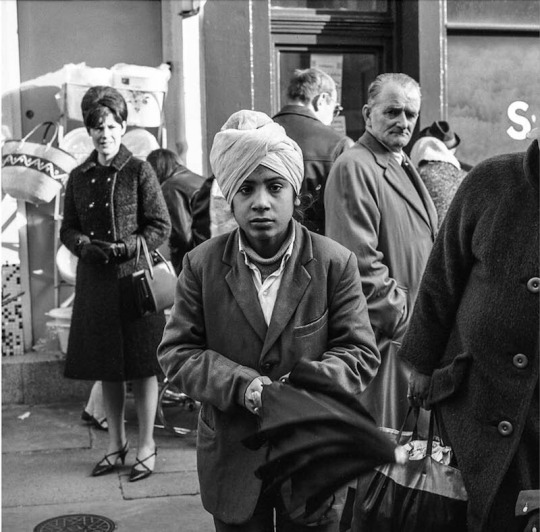
She is known for her black and white photography but she only truly turned to colour polaroid photos in the 1980s. But what remained central was the human figure in its natural setting is still the primary focus of her work and she continues to use photography in its purest, un-manipulated form, her approach had become more painterly and allusive, with an ever greater interest in spatial and other forms of ambiguity.
She had her first solo show in 1969 at the ICA, where her exhibition, “People at Peace”, was juxtaposed with “The Destruction Business”, a selection of Don McCullin’s war photography. Her first photobook, A World Observed, was published the following year.
Her photographic output decreased during the 1970s as she helped to build the reputation of the Photographers’ Gallery, which opened in 1971 in a former Lyons Tea Room in Covent Garden. As an associate director for 15 years, she worked on exhibitions of veteran snappers and emerging talents such as Sarah Moon and Colin Jones. She photographed well into her 90s, often around her neighbourhood in Hampstead, continuing to capture quiet, dignified moments. A photograph, she said, “makes transience less painful”.
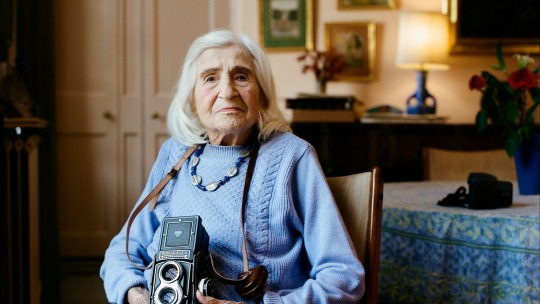
In her later years, Dorothy Bohm reflected that England had been her salvation. “It’s the best country, I can tell you that, and I’ve lived in a number of them,” she noted, “Why? Because of the people.” Photography for her, as she would confess in countless interviews, was essentially a coping mechanism for loss, “I am temperamentally suited to being a photographer. You can only make a picture of something that exists, right? And for me that was quite important. I wanted to capture time. My background completely disappeared.”
RIP Dorothy Bohm (1924-2023)
#bohm#dorothy bohm#quote#photographer#art of photography#street photography#britain#femme#visual art#photography#society#culture#class#icon
76 notes
·
View notes
Text

Born into an Anglo-Irish and Welsh family in London on January 1, 1897, Edward Morgan Forster was originally intended to be called Henry, though at his christening he was accidentally baptized Edward. This also being his father's name, young Edward became known in family circles as Morgan, so as to differentiate him from his father.
Considered one of the greatest English novelists of the twentieth century, E.M. Forster was educated at Tonbridge School, and later King's College, Cambridge; where, as an undergraduate, he became a member of a the Apostles; a society who met in secret to discuss their work on and about philosophical and moral questions; the group later being known as the Bloomsbury Group (sometimes referred to as the Bloomsbury Set). He advocated individual liberty and penal reform; opposed censorship; was President of the Cambridge Humanists, and also a member of the Advisory Council of the British Humanist Association; his views as a humanist, being at the heart of his work, which often depicts the pursuit of personal connections in spite of the restrictions of contemporary society.
A gay man, Forster developed a long-term relationship with Bob Buckingham; Forster's circle of friends also including Benjamin Britten, Christopher Isherwood, Siegfried Sassoon and Forrest Reid.
E.M. Forster was elected an honorary fellow of King's College, Cambridge; declined a knighthood in 1949; was made Companion of Honour in 1953; and made a member of the Order of Merit in 1969.
When Forster's cousin, Philip Whichelo, donated a portrait of Forster to the Gay and Lesbian Humanist Association (GLHA), Jim Herrick, the founder, quoted Forster's words: 'The humanist has four leading characteristics – curiosity, a free mind, belief in good taste, and belief in the human race'.
Edward passed on June 7, 1970. He was 91. His ashes, mingled with those of Buckingham, were later scattered in the Rose Garden of Coventry's crematorium, near Warwick University.
*
'Maurice' (1971; published posthumously): a homosexual love story set in early twentieth century England, which follows its main character, 'Maurice Hall' (played by James Wilby in James Ivory's 1987 film adaptation for Merchant Ivory Productions), through university, a tumultuous relationship with 'Clive' (played by Hugh Grant), his struggles to fit into society, and ultimately being united with his life partner, 'Alec' (played by Rupert Graves).
Ivory's usual writing partner being unavailable, he wrote the screenplay with Kit Hesketh-Harvey; who, like Forster, had also been educated at Tonbridge School and Cambridge University, and therefore knew the background. Ivory later said: 'What Kit brought to the script was his social background […] His knowledge of the British upper middle class was incredibly useful – the dialect, the speech, the slang, and so many other things. As an American, I could not have possibly written the script without him'.
The film was largely shot on location in the halls and quadrangles of King's College, Cambridge, including interiors in the college's chapel; the other interiors, primarily shot at Wilbury Park, a Palladian house in Wiltshire.
53 notes
·
View notes
Text
By: Jacqui Frost
Published: Jan 11, 2024
Shared testimonies, collective singing, silent meditation and baptism rituals – these are all activities you might find at a Christian church service on a Sunday morning in the United States. But what would it look like if atheists were gathering to do these rituals instead?
Today, almost 30% of adults in the United States say they have no religious affiliation, and only half attend worship services regularly. But not all forms of church are on the decline – including "secular congregations," or what many call "atheist churches."
As a sociologist of religion who has spent the past 10 years studying nonreligious communities, I have found that atheist churches serve many of the same purposes as religious churches. Their growth is evidence that religious decline does not necessarily mean a decline in community, ritual or people's well-being.
What is an atheist church?
Secular congregations often mimic religious organizations by using the language and structure of a "church," such as meeting on Sundays or hearing a member's "testimony," or by adapting religious language or practices in other ways.
For example, there are a growing number of psychedelic churches, which cater to people looking to experience spirituality and ritual through drug use.
There are also secular organizations that promote the idea that people can live forever, such as the Church of Perpetual Life. Members believe they can achieve immortality on Earth through radical life-extension technologies such as gene editing or cryonic preservation – freezing bodies after death in hopes that they can someday be resuscitated.
These secular congregations often appeal to atheists and other secular people, but their main purpose is not promoting atheism.
However, "atheist church" organizations like the Sunday Assembly and the Oasis explicitly celebrate atheists' identities and beliefs, even though not everyone who attends identifies as an atheist. Testimonies and activities extol values like rational thinking and materialist philosophies, which promote the idea that only physical matter exists.

[ British comedian Sanderson Jones leads the Sunday Assembly, a "godless congregation" for atheists that started in England, at Wooly Mammoth Theatre in Washington, D.C. ]
There are also long-standing humanist and ethical communities that promote secular worldviews and provide secular ceremonies for major life transitions, like births, funerals and weddings. The American Humanist Association, for example, describes its values as "Good without a God." And for decades, Unitarian Universalist congregations, which grew out of Christian movements, have drawn on teachings from both religious and nonreligious traditions, without imposing specific creeds of their own.
But there has been a recent rise in secular congregations that explicitly mimic religious organizations and rituals to celebrate atheistic worldviews. Many have just one or two chapters, such as the Seattle Atheist Church and the North Texas Church of Freethought.
However, Sunday Assembly and the Oasis have networks with dozens of chapters, and Sunday Assembly has been dubbed the "first atheist mega-church". Many chapters of Sunday Assembly see hundreds of attendees at their services.
Testimonies, singalongs – but nothing supernatural
Many features of atheist churches in the U.S. are directly borrowed from religious organizations. At Sunday Assembly, where I spent three years doing research, services include collective singing, reading inspirational texts, silent reflection and collecting donations. They center around a central lecture given by a member of the congregation or a member of the larger local community. I attended one service where an astronomer gave a talk about the New Horizons spacecraft's mission to Pluto. At another service, a member of a local community garden organization talked about building community through her community garden program.
Atheist church organizers I met told me that they intentionally borrow the structure of a church because they see it as a good model for building effective rituals and communities. More generally, the structure of a "congregation" is popular and familiar to most attendees.
However, there are key differences. Sunday Assembly has no hierarchical structure, and there is no pastor or minister, meaning that decisions are made by the community. Attendees share duties for running the services and finding speakers and readings.
The other key difference is the complete lack of reference to the supernatural. Lectures and rituals I have encountered at atheist church services are centered around affirming atheistic beliefs, celebrating science, cultivating experiences of awe and wonder for nature, and creating communities of support.
Sociologists of religion call these practices "sacralizing the secular" and "secular spirituality": activities that enable nonreligious people to express their shared beliefs and cultivate a sense of belonging and purpose.

[ British comedians Sanderson Jones, right, and Pippa Evans, second from left, co-founders of The Sunday Assembly, an atheist service held at a converted church, lead the congregation in song during a service in north London, on March 3, 2013. Echoing with joyful song and with a congregation bent on leading better lives, this London church is like any other — except there's no mention of God. ]
One example is collective singing: borrowing a familiar aspect of religious services that can give members a sense of transcendence. Most Sunday Assembly chapters have church bands that lead singalongs to pop songs like "Livin' on a Prayer" by Bon Jovi and "Brave" by Sara Bareilles. When the astronomer talked to Sunday Assembly about NASA's mission to Pluto, the congregation sang "Across the Universe" and "Lucy in the Sky with Diamonds" by the Beatles to reinforce their reverence for the vastness of the universe.
Another borrowed ritual is the sharing of testimony. Many Sunday Assembly services involve a member standing in front of the congregation to share something they learned recently, to express gratitude, or to affirm their atheistic beliefs by sharing why they left religion.
Some atheist communities, although not Sunday Assembly, even engage in "debaptism" ceremonies in which they renounce their former religion. Some atheists I interviewed sent their debaptism certificates to their former churches as a way of solidifying their new nonreligious identity.
Change ahead?
As rates of religious affiliation continue to decline, many scholars and pundits have argued that there will be a decline in community engagement and other important indicators of well-being, such as health, happiness and people's sense of meaning and purpose.
However, atheist churches are an example of how nonreligious Americans are finding new ways to meet those needs. A member of Sunday Assembly told me: "I honestly can't think of a word to describe it. I mean, 'life-changing' sounds stupid, but Sunday Assembly just helped so much. I've always struggled with depression, and I'm so much happier now that I have this group of friends who share my beliefs and who are trying to do good out in the world with me."
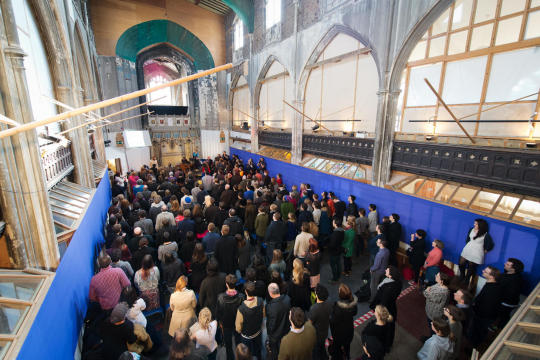
[ Members of the congregation attend as British comedians Sanderson Jones and Pippa Evans, co-founders of The Sunday Assembly, an atheist service held at a converted church, lead the service in north London, on March 3, 2013. Non-believers worldwide have contacted organizers to ask how they can set up their own branch. ]
Atheist churches are still fairly new, but studies have shown that participation in them and other types of atheist organizations can bring social and emotional benefits. In particular, it can help atheists buffer the negative effects of experiencing stigma or discrimination.
Whether the atheist church trend will continue remains to be seen. But such churches' recent growth is evidence that they can work much like religious organizations to build community, cultivate rituals and bolster well-being in a time of religious change.
==
Yeah, I don't know about this.
#Jacqui Frost#atheism#atheist church#secular#secular congregation#decline of religion#rise of the nones#leaving religion#empty the pews#secularism#no religion#irreligion#non religious#religion is a mental illness
7 notes
·
View notes
Text
The Luciferian United Nations
Starting with Helena Blavatsky.
“Lucifer represents... Life... Thought... Progress... Civilization... Liberty... Independence... Lucifer is the Logos... the Serpent, the Savior.”(‘The Secret Doctrine’ by Helena Blavatsky pages. 171, 225, 255, Volume II
)“It is Satan who is God of our planet and the only God” pages 215, 216, 220, 245, 255, 533, (VI)
“The Celestial Virgin which thus becomes the Mother of Gods and Devils at one and the same time: for she is the ever-loving beneficent Deity…but in antiquity and reality Lucifer or Luciferous is the same, lucifer is divine and terrestrial Light, ‘the Holy Ghost’ and “Satan” at one and the same time.” Page 539
Blavatsky was the founder of the Theosophical Society and was a major influencer of Alice A. Bailey.
Bailey, with her husband Foster started an official NGO within the UN called World Goodwill whose goal is to “cooperate in the world of preparation for the reappearance of Christ”. Bailey claims: “Evidence of the growth of the human intellect along the needed receptive lines [for the preparation of the New Age] can be seen in the 'planning' of various nations and in the efforts of the United Nations to formulate a world plan... From the very start of this unfoldment, three occult factors have governed the development of all these plans.” SOURCE: [Alice B. Bailey, Discipleship in the New Age (Lucis Press, 1955), Vol. II, p.35.]
“Within the United Nations is the germ and seed of a great international and meditating, reflective group - a group of thinking and informed men and women in whose hands lies the destiny of humanity. This is largely under the control of many fourth ray disciples, if you could but realize it, and their point of meditative focus is the intuitional or Buddhic plane - the plane upon which all hierarchical activity is today to be found.” [Ibid. p.220.]
Robert Muller, was an international civil servant with the United Nations. Serving with the UN for 40 years and rising to the rank of Assistant Secretary-General, his ideas about world government, world peace and spirituality led to the increased representation of religions in the UN, especially of New Age Movement. He was known by some as "the philosopher of the United Nations". He created at least 29 schools around the world earning him the UNESCO Peace and Education Prize in 1989. He is also known as the “father of global education.”
“The underlying philosophy upon which the Robert muller school is based will be found in the teachings set forth in the books of Alice A. Bailey (Lucis Trust is the Publishing House which prints and disseminates United Nations (UN) material. Lucis Trust was established in 1922 as Lucifer Trust by Alice Bailey as the publishing company to disseminate the books of Bailey and Madame Blavatsky and the Theosophical Society. Due to public outrage over the creepy name of the publishing company, it was changed one year later to Lucis Trust.)…The school is now certified as a United Nations Associated School providing for international cooperation and peace.” – Muller, R. World Core Curriculum (Preface)
“A world core curriculum might seem utopian today. By the end of the year 2000 it will be a down-to-earth, daily, reality in all the schools around the world.” R. Muller, A World Core Curriculum (n.p., n.d.), p. 13.
The Muller school is the education program for the world as will be enforced by the United Nations. He created the World Core Curriculum that is being seeped into education systems around the world by UNESCO, (search ibe.unesco.org) UNESCO’s vision from their page is “develops educational tools to help people live as global citizens free of hate and intolerance”. (in other words, one world education but through in the terms “hate and intolerance” to make it sound positive).
It’s first Director was Julian Huxley. Huxley was a member of the Communistic Colonial Bureau of the British Fabian Society, signer of the Humanist Manifesto II. An Evolutionist, and member/vice-president (1937-44)/president (59-62) of the British Eugenics Society, and not only a transhumanist but coined the phrase transhumanism.
Under Huxley’s guidance the UN created a “guidebook” for teachers. Within this guidebook the teachers are reminded that the first step to educating a child to be a World Citizen, is the DESTRUCTION of a child’s love of country and patriotism. (John A Stormer, None Dare Call It Treason, Florissant, Missouri: Liberty Bell Press, 1964 p.112)
In Volume V it reads, “In the classroom children under thirteen years of age: Before the child enters school, his mind has already been profoundly marked and often INJURIOUSLY, by earlier influences…first gained, however dimly, in the home.”
Also, “the kindergarten or infant school has a significant part to play in the child’s education. Not only can it correct many errors of home training, but it can prepare the child for membership, at about age seven, in a group pd his own age and habits – the first of many such social identifications that he must achieve on his way to membership in the World Society.”
(HEY, REMEMBER THAT TIME BIDEN SAID THAT WE HAD TO START SENDING OUR KIDS TO SCHOOL AT AN EARLIER AGE?)
-“As we have pointed out, it is the family that INFECTS the child with EXTREME NATIONALISM. The school should therefore use the means described earlier to COMBAT FAMILY ATTITUDES”
.-“In our view, history and geography should be taught at this age as UNIVERSAL history and geography… The study of history… raises problems of value which are better POSTPONED UNTIL the pupil is FREED FROM THE NATIONAL PREJUDICES which at present surround the teaching of history”.
UNESCO’s Constitution was written by Archibald MacLeish, a Skull and Bones member.
One of many organizations under UNESCO is SIECUS.
Within the SIECUS positions was this, “it is the position of SIECUS that contraceptive services should be available to all- including minors who should enjoy the same rights of free and independent access to…contraceptive care as do others…It is the position of SIECUS that the use of explicit materials (sometimes referred to as pornography) can serve a variety of important needs in the lives of countless individuals”. (Chronology of Education Quotable Quotes 1994 p.37.
(YOU SEE HOW THEY STARTED WITH SEX ED, THEN EVOLVED OVER TIME INTO GAY PORN AND TRANSKIDS WITH JACKED UP SENSE OF PRONOUNS?)
Now you may think this is ALL about a SECULAR N.O.W., you would be wrong.
In 1973, the UN Secretary U Thant formed the organization Planetary Citizens with NEW Activist Donald Keys. An NGO within the UN specifically “devoted to preparing people for the coming of the new culture”.
Donald Keys was actively involved with the Findhorn Community in Scotland. He writes, “The New Age groups are focusing and enter a new stage- a world related stage. They are becoming mature enough to begin to shoulder some of the load of humanities burdens… The spread of the New Age values as a unifying “yeast” in the human loaf may be the critical ingredient for successful emergence from the 1980’s onward.”
Findhorn books are slam full of New Age occultic speech, doctrine, and symbols.
Their spokesman was once David Spangler, (I say once because Spangler seems to be scrubbed from their works along with ties to the UN, and he wasn’t the only on I found like this).David Spangler is quoted, “The true light of Lucifer cannot be seen though sorrow, through darkness, through rejection. The true light of this great being can only be recognized when one’s own eye in the inner sun. Lucifer works within each of us to bring us wholeness, and as we move into a New Age, which is the age of man’s wholeness, each of us in some way is brought to that point which I term the LUCIFERIAN INITIATION, the particular doorway, through which the individual must pass if he is to come “fully” into the presence of light and his wholeness…Lucifer comes to give us the final gift of wholeness”. David Spangler, Reflections on the Christ (Scotland, Findhorn Publications 1977 p.43-44). (THAT SOUNDS A LOT LIKE ALBERT PIKE AND MANLY P HALL)
This was almost a week worth of research, just in order to whittle it down to this short post. The amount of info, ties, and connections between occultism, nations, Rome, and politics, secret societies, and more was exhausting. There is so much more, going on for so long, and nothing is going to stop this. So wherever you are when it comes to God, this is where we are being led. Wherever you are when it comes to a political candidate, remember these things next time you hear them going on about the “issues Americans care about”. Because the whole time they have distracted us with borders, taxes, inflation, scandals, the size of a candidates hands, and on and on, this shit right here...has kept growing and growing like cancer. No one side talks about it because they all know. They are all a part of it, playing a role to distract each of us.
#united nations#lucifer#donald trump#joe biden#new world order#new age#spiritualism#jesussaves#jesus christ#freemasons#secret society#american politics#politics
78 notes
·
View notes
Text
This is the Official Public Relations Account for the Merseyside and Greater Manchester Post-Post-Post-Modern Crypto-Neo-Marxist Progressive Gnostic Transhuman Antifascist Anarcho-Totalitarian Posadist Woke Moralist Society.
(Comprised Primarily of the Northwest England Post-Post-Post-Modern Neo-Marxist Association (AKA the Anti-Petersonian Guild), the Orrell chapter of Antifa, the Greater Manchester Transgender Polycule, Neo-Erisians Against TV Licensing, the Wigan Trans-Humanist Syndicate, the Erwin Schrödinger Anarcho-Totalitarian “Order” of Leigh, Assorted Indoctrinated Youths, and Every Major Official In the Government of the United Kingdom.)
INFO:
1984 is when there are Trans People.
It is happening Right Now, Because of Us.
It is Sick as Hell.
If you so much as Think someone's Deadname, We will Detect It with the Vaccine Microchips and Email you Anthrax.
Every Single Teacher in This College is Under Our Thumb, just as Every Politician in the Country bends to Our Woke Agenda.
Soon, KING CHARLES will reveal a Preference for He/They Pronouns on the Official Royal Family Twitter Account.
We will then Step from the Shadows and Assume Control with them as a Figurehead.
The Noble Lone Warrior of Truth known as ALEX JONES was the only person with the Power to Stop Us.
Now that he has Lost That One Lawsuit, Our ULTIMATE VICTORY is INEVITABLE.
Also the British Values Thing is a Psyop to make Zoomers think that Being Patriotic is Cringe
Status as an Extension of the PPPMCNMPGTAATPWN Society Official Hivemind is Indicated via the Tab from a Drink Can Attached to one's Lanyard.
We will not Follow Back unless you have given Us Explicit Permission to Do So. (As the Blogs that We are Following are Public)
DNI: Anyone Who Is Over 6' Tall, People Who Understand More Than Three-Quarters of the Words in Our Name, The French, Users of Non-Neopronouns (she/her, he/him, etc), People who Have DNIs, Sigmund Freud, Professor Philip 'Bitch' Zimbardo
-)(-
if you are the government (college staff etc) or just confused, real world info is here (not a rick roll we promise)
6 notes
·
View notes
Text
Lecture Notes MON 22nd JAN
Masterlist
BUY ME A COFFEE
The Artwork in History: ‘Renaissance’ Art
‘Renaissance’ word association:
Rebirth, revival, Florence, Michelangelo, Leonardo, Raphael, dropping church, Christian art/ Madonna, dissection, revival, revival of Antique, Sistine Chapel, Bronze Sculpture, Medici
Compared to the words suggested surrounding ‘Medieval’, these highlight a far greater knowledge and specialisation. Presenting specific artworks, people, and places. Unlike in ‘Medieval’ which presents a greater generalisation and vagueness.
We begin the study of the ‘Renaissance’ by looking at the origins of the term/name of the period. It’s key to note that periods/movements do not have specific names during the time those artists that make those movements up are alive/create. Periods and movements usually are named after they have elapsed and passed, as well as certain meaning being prescribed to them. Although, that isn’t always the case, as for the pre-Raphaelite Brotherhood: the artists named themselves this and wrote a manifesto. Also, the closer we get to the present day, the more smaller niche movements we have happening. Partly due to knowing more, and the evolution of art and its accessibility.
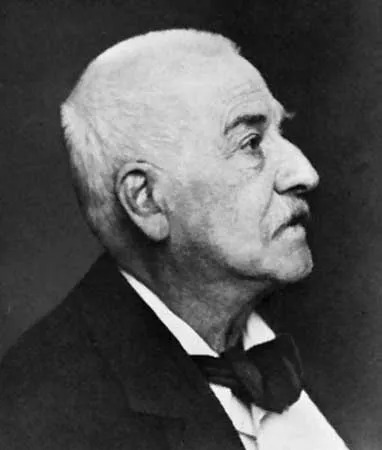

Jacob Burckhardt (1818-1897)
So, the ‘Renaissance’, coined by Jacob Burckhardt. A German writer. The term comes from the French, writing a book about 15th century Italy. Although his book is slightly problematic in the sense that it doesn’t actually recommend or document any art in this so called “art-history” book.
A good example of ‘Renaissance’ art is Botticelli’s ‘Birth of Venus’. As this period of art heavily focuses on retelling classic myths, filled with antique symbolism. A reason a lot of people cite this painting is due to its immense size. A good rule of thumb as an art historian is that if it’s big, it’s important. While the period looks back on Pagan mythology, the religion however doesn’t come back. In fact, more people turn to and cite this period as one of Christian art. Theres a lack of revival of paganism, but there is a revival of form. Observe this statue:


(Right)Sandro Botticelli, The Birth of Venus, tempera on canvas. 172.5 cm x 278.9 cm, Uffizi, Florence
(Left)Aphrodite/Venus, Roman, Metropolitan Museum, New York
The pose is near identical to that of the Classical Antiquity Venus, so we have some semblance and idea of where these artists were drawing their inspiration from. Whereas the ‘Medieval’ was a little bit more complicated. But the ‘Renaissance’ also makes us question as to where the people were looking to for inspiration and evolving their ideas from?
The historical awareness surrounding the Renaissance, highlights to us how they were copying and reviving Classical Antiquity, it’s also safe to say that near always in history we look back on Classical Antiquity and revive aspects of it in some manner/form.

Arch of Constantine
The Renaissance is closely associated with the visual arts. However, it’s more focused on words and the physical surprisingly.
Humanistic Script:
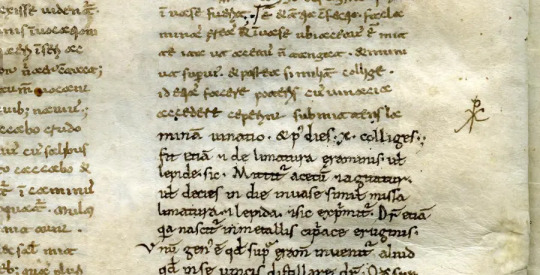
Humanistic script
Ser Giovanni di Piero da Stia, Florence, early fifteenth century
BL Harley 3426
A revival of Roman Latin occurs, and an interest in what people wrote/how they physically wrote. This prevails in the modern day, as Humanistic Script is what influences todays cursive and joined handwriting. The physical print was also important, as the Renaissance was concerned with how you spelled Latin, causing a reformation of vocab/style. Considered Roman handwriting.
While the Roman’s wrote on wax tablets, this left us with quite little to study/go off of. Apart from the in-scriptures on buildings. Surprisingly, although it was a revival of Roman Latin it was modelled on ‘Medieval’ handwriting: the earliest surviving copy is a copy of Vitruvius. Located in the British Library. Carolingian script (aka a Romanising of Medieval handwriting).



(Left) Gothic script. North Italy, thirteenth century
(Right) Carolingian script An early ninth century copy of Vitruvius, British Library
Humanists were mainly concerned with text/writing.
Leonardo Bruni (tomb analysis): classical poetry doesn’t rhyme, its focus more on flow.
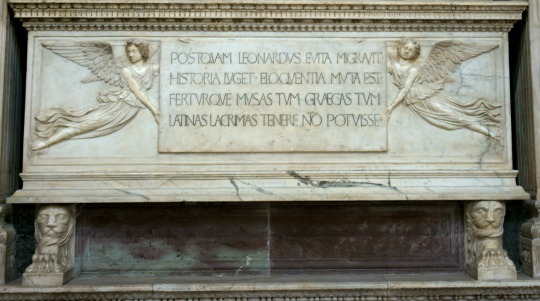
Bruni’s epitaph by Carlo Marsuppini
Literary and scholarly revival is actually the first thing that occurs in the Renaissance, then followed by the visual arts. The scholars worked with people in power or with people whom they shared values with. While most people name Florence as the city of the Renaissance, which it was, they are usually wrong on the city part. Florence was a republic, standing against tyranny.
Text -> Building (Architecture) -> Visual Arts
Looking at these buildings there are clear associations we can begin to link to Renaissance Architecture: simplicity, proportion, understated elegance, columns with entablature, dainty, refined and light.

Filippo Brunelleschi, Foundling Hospital, Florence, 1419-24

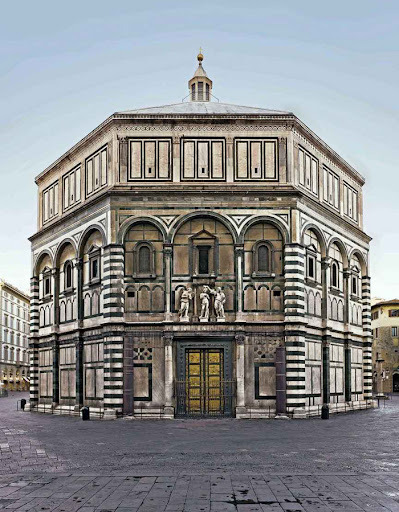
Baptistery, Florence Late 11th or early 12th century
When considering what the Renaissance people were reviving? It’s hard to imagine it’s the Roman buildings (‘Medieval’ post for more information), as that style was far heavier, more solid.
A name that most will recognise, is that of: Filippo Brunelleschi. The most popular architect of the time. Historians believe that rather than looking and reviving Roman Architecture or even studying it, it was Medieval architecture. The aforementioned Baptistery is a prime example of this confusion, considering this building to be a revival of Classical Antiquity when in fact it hails most of its design and inspiration from the Medieval.

Brunelleschi, Old Sacristy, San Lorenzo, c.1418-28 The tomb of Giovanni di Bicci de’ Medici (1360-1429) is at the centre
Florence, especially during this time has an important self-image, and is quietly and privately ruled by the Medici family. You’ll see their name come up a lot in art of this time, as they bolstered their position with the visual arts.
Another important figure, whose name is not as wildly known is Leon Battista Alberti, another Architect, although he dabbled really in Architecture. He was first a scholar and a writer: Humanist.
His work was more focused on borrowing than copying. It’s especially in his architecture that you see the greater details and referencing to Classical Antiquity, rather than in text.

Leon Battista Alberti, Façade of Sant’ Andrea, Mantua, c1470


(Left) Arch of Trajan, Ancona, 115CE
(Right) Arch of Titus, Rome, c80CE
Brunelleschi claims to have used certain styles/ references in his biography, which was written in his late life. However, Historians aren’t too convinced by his claims. Really instead of copying, the Renaissance developed motifs.
Nudes are considered Classical Antiquity.


(Left)Apollo Bonacolsi, called Antico Apollo, 1490s
(Right)Apollo Belvedere Discovered late15th century
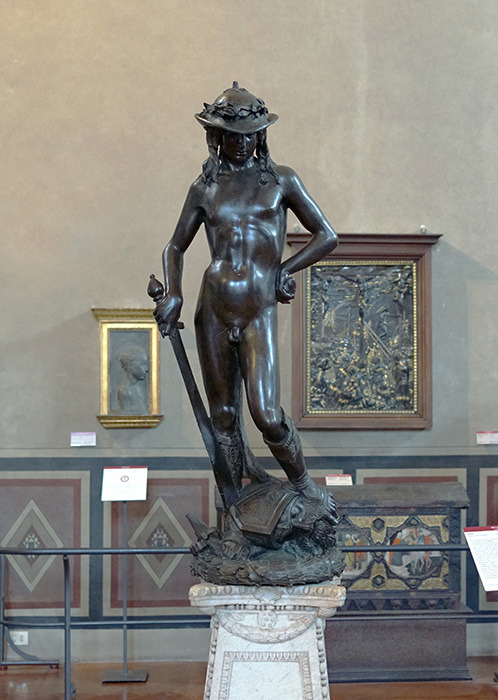
Donatello, David, 1440s?, bronze, 1.58m, Bargello, Florence
Moreover, the bronze sculptures use a specific recipe to achieve a certain finish. The original recipe used by the Romans was lost in history, and thus the Renaissance came up with their own one. And while I reference Donatello’s David, just because it’s popular now, doesn’t necessarily mean it was popular originally/during that time in history.
A revival of Portrait Busts and Side Profile studies occurred:

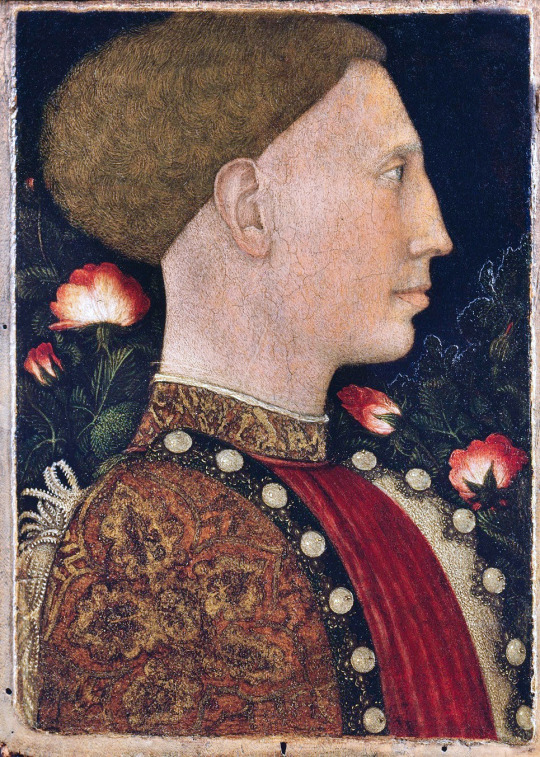
(Left)Antonio Rossellino Portrait bust of Matteo Palmieri, 1468, Bargello, Florence
(Right)Pisanello Portrait of Leonello d’Este, 1441
It’s also in 15th century Florence that we see great technical developments be achieved within art, like Geometrical lines indicating to perspective work, light source and shading, construction. All partially being influenced and being attributed to the Arabic optical studies.
Here in this Masaccio the perspective development can be observed.

Masaccio Trinity, 1420s, Santa Maria Novella, Florence
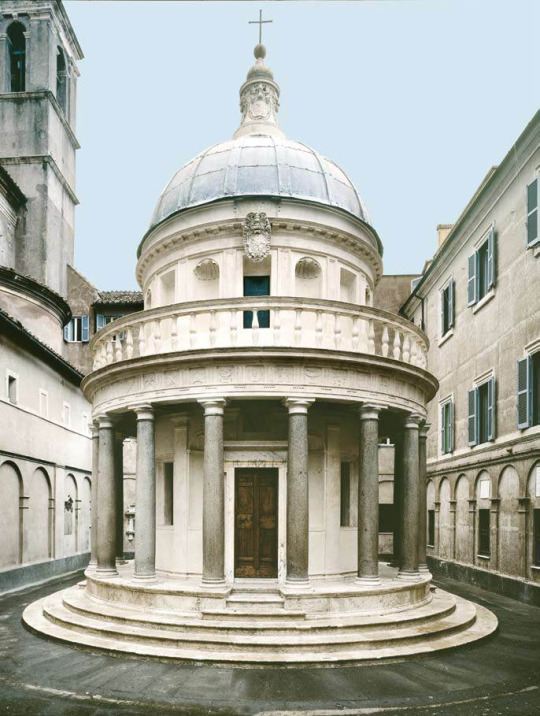
‘High Renaissance’ Bramante, ‘Tempietto’, c.1502, San Pietro in Montorio, Rome
PART 2 OF POST: MASACCIO
#art#art gallery#art hitory#artwork#writing#art tag#essay#paintings#art exhibition#art show#art history#architecture#renaissance#essay writing#lecture#learn#history lesson#historical#history#artists#traditional art#academic writing#writers#writer stuff#writeblr#writers on tumblr#light academia#dark academia#drawings#drawing
3 notes
·
View notes
Photo

10 Gruesome Facts about the French Guillotine
1. It was not actually invented by Dr. Joseph-Ignace Guillotin
Though his name is linked with the device, Dr. Joseph Guillotin (French doctor, politician and humanist) did not invent it rather he aided in the creation. Guillotin was actually against the death penalty, but seeing as his colleagues were not keen on abolishing it, he then advocated pain-free methods of execution. Guillotin’s relatives were so embarrassed that their family name was associated with decapitation that they requested for the device’s name to be changed. Upon the French government’s refusal, the Guillotin family changed their own name.
2. It wasn’t the first decapitation device
Since the Middle Ages the British had been using a decapitation device dubbed the ‘Halifax Gibbet’. The first recorded use of the Halifax Gibbet was in 1286 in Halifax, England. The gibbet differs from the guillotine in that a rope must be cut for the blade to descend. Complications arose due to the crescent shape of the blade, unlike its angled guillotine counterpart.
3. People booed after witnessing the first public guillotining
Many people turned up at Place de Grève out of curiosity on April 25, 1792 to witness the first public execution using the new mechanized device. Nicolas Pelletier had been sentenced to death for theft and violently resisting arrest. The crowd was not at all impressed with the anti-climactic swiftness of the blade. In a few seconds, it was ‘game over’, and they felt cheated out of a few hours of entertainment. (Normally public executions included torture and hanging.) The crowd wasn’t won over by the ‘modern machine’ and they even booed executioner, Charles-Henri Sanson.
4. Guillotine earrings and toys for the kids?
During the height of the first French Revolution, executions were so frequent in Paris that they attracted large crowds. People even brought their children to witness these events, and industry popped up around the scaffolds. There were food booths and leaflets were printed listing the names of the condemned as macabre souvenirs. A group of older ladies called ‘les Tricoteuses’ (the knitters) would spend the whole day knitting while watching the blade crash. Some fervently patriotic ladies actually wore guillotine earrings, and miniature working guillotines were a hit with both adults and children alike.
5. Nazis slaughtered over 16,000 people by guillotine
Hitler ordered the guillotine as a method of execution in the 1930s, and ordered that 20 of the machines be placed in cities across Germany. According to Nazi records, the guillotine was eventually used to execute some 16,500 people between 1933 and 1945, many of them resistance fighters and political protesters.
6. You can actually go see the last guillotine blade in Paris
A guillotine blade that was used during the first French Revolution at Place de Grèves (now place de l’Hotel de Ville) can be viewed at the Police Museum (Musée de la Préfecture de Police), located on the third floor of an active police station in the Latin Quarter.
7. Marie Antoinette handled the guillotine with grace while Louis XVI came close to avoiding it
Louis XVI was the first member of the royal family to be executed on January 12, 1793, but it was only by a slim margin (361 votes in favour to 288 votes against). Unfortunately for him, his cousin Louis Philippe d’Orléans supported his death. On October 16, 1793, Marie Antoinette’s dying words were “I’m sorry.” This was a courteous gesture after she stepped on the executioner’s foot and not a reference to any offenses against the republic.
8. Guillotine operators were well-known in their country
As the guillotine’s notoriety increased, so did the reputations of those who used it. During the French Revolution, executioners gained a tremendous degree of reputation because of how well and rapidly they could plan several beheadings.
Family businesses frequently ran the job. From 1792 through 1847, many generations of the renowned Sanson family carried out hundreds of executions, including that of King Louis XVI, Marie Antoinette, and other notable individuals. Louis and Anatole Deibler, a father and son team whose total career spanned from 1879 to 1939, held the position of chief headsman during the 19th and 20th centuries.
9. Brutal research was done on the heads of condemned people by scientists
When an assistant executioner smacked one of his victims in the face and witnesses said they saw the victim’s cheeks flush with rage, the controversy reached new heights in 1793.
In order to see if a child killer who had been executed by the guillotine would regain consciousness and speak, a doctor by the name of Dassy de Lignieres even injected blood into the victim’s brain. The gruesome tests came to an end in the 20th century, but investigations on rats have subsequently revealed that brain activity may persist for up to four seconds after decapitation.
10. The last public execution in France took place in 1939
Eugen Weidmann and two other men were implicated in a serial kidnapping, robbery and murder ring. Their victims were primarily tourists visiting Paris. The subsequent trial was gruesome, sensational, and turned into a media circus. Weidmann was found guilty, and sentenced to death for his crimes. A large crowd gathered on the morning of June 17, 1939 outside of the Saint-Pierre Prison in the town of Versailles to witness the spectacle. Instead of the usual silence and solemnity, they were boisterous and quasi-hysterical. After the execution was carried out, members of the frenzied crowd launched themselves onto the blood-soaked ground in order to dab various items in it for macabre souvenirs. Adding to the scandal, it was later discovered that the execution had been secretly filmed.
40 notes
·
View notes
Text


❝ let's take a walk on the d a r k s i d e then. ❞
« jack mullarkey, 30, he/him, dc comics » ∙∙ loading case file for john constantine. known aliases, if any: the hellblazer. current location: new york, new york. current occupation: occult detective. he is known to be quick-witted and selfish, so proceed with caution. their current alliance: civilian. penned by ree. ©
GENERAL DETAILS.
full name: john thomas constantine.
nickname(s): johnny, conjob.
name meaning: "god is gracious."
age: thirty.
date of birth: may 10, 1992.
place of birth: liverpool, england.
ethnicity: white.
gender: cis man.
pronouns: he/him/his.
sexual orientation: bisexual.
romantic orientation: biromantic.
religion: unaffiliated.
occupation: occult detective.
education level: general certificate of education (gce).
living arrangements: bounces from one place to another; was homeless for several months when he was 16 after being kicked out of his childhood home by his father.
speaking voice and accent: british.
spoken languages: english, latin, ancient greek, hebrew, sanskrit, ect.
PHYSICAL APPEARANCE, ETC.
faceclaim: jack mullarkey.
hair color and style: blonde, clean cut.
eye color: blue.
height: 6'0".
weight: 158 lbs.
body and build: lanky, somewhat muscular.
tattoos: several incantations of varying languages inscribed on his forearms, similar to the tattoos he has in the injustice comics.
piercings: helix piercing in both ears, yet they've mostly closed up.
clothing style: typically formal wear with a tie and trenchcoat.
distinguishing characteristics: dimpled chin and piercing blue eyes.
signature scent: silk cut cigarettes.
HEALTH.
mental disorder(s): suffers from depression and post-traumatic stress disorder, as well as brief instances of psychosis following the incident in newcastle when he damned a young girl’s soul to hell by accident.
physical disorder(s): lung and cardiovascular complications due to his chain smoking.
allergies: cats.
sleeping habits: often experiences insomnia and has difficulty falling asleep. he also just stays up until ungodly hours.
eating habits: a lot of instant noodles and hot pockets.
sociability: he’s rather sociable unless he’s going through a rough time. it’s others who’d prefer not to associate with him given his track record of dead friends and family members.
addictions: nicotine.
drug abuse: in his early twenties, he was on antidepressants and prescribed olanzapine by his doctors at ravenscar psychiatric institute, where he was a patient for two years.
alcohol use: will go on a bender every once in a blue moon but usually sticks to a glass of whiskey (or several) each night.
PERSONALITY.
label(s): the con artist, the devil’s advocate, the bibliophile, the karma houdini, the narcissist, the hellion, the addict, the deadpan snarker, the anti-hero.
positive traits: charismatic, persuasive, humanistic, pragmatic, quick-witted.
negative traits: cunning, selfish, arrogant, cynical, self-loathing.
astrology: taurus.
personality type: entp.
moral alignment: chaotic neutral.
hogwarts house: slytherin.
element: fire.
primary vice: pride.
primary virtue: diligence.
weather: rainstorm.
color: orange/gold.
music: the clash.
movie: blade runner.
book: the island of doctor moreau.
sport: rugby.
beverage: whiskey.
food: bacon and eggs.
animal: fox.
season: autumn.
FAMILY.
mother: mary anne constantine (died in childbirth).
father: thomas constantine (deceased).
significant other: n/a.
best friend: chas chandler.
exes: zatanna zatara, oliver (ex-boyfriend), nightmare nurse, several meaningless flings.
sibling(s): cheryl masters, sister (murdered by her husband), unnamed twin brother (died in the womb).
children: n/a.
extended family: tony masters, brother-in-law (deceased), gemma masters, niece.
pet(s): n/a.
short bio: after a botched exorcism in his adolescence led to an innocent girl named astra logue being damned to hell, john has been running from the demons of his past and drowning his sorrows in a bottle of liquor, all while leaving a trail of dead bodies in his wake. a conman by trade and savvy occult detective on nights he’s not conjuring demons, john’s spent the last several years swindling the streets of london with his impressive wit and token charm.
6 notes
·
View notes
Text
Ian Bushfield on the British Columbia Humanist Association
Author(s): Scott Douglas Jacobsen
Publication (Outlet/Website): The Good Men Project
Publication Date (yyyy/mm/dd): 2024/01/28
Ian Bushfield’s website biography states: “…[He] is an advocate for Humanism, science and social justice living in Metro Vancouver. He is the current and was the first Executive Director of the BC Humanist Association. He co hosts the PolitiCoast and Cambie Report…
View On WordPress
0 notes
Photo
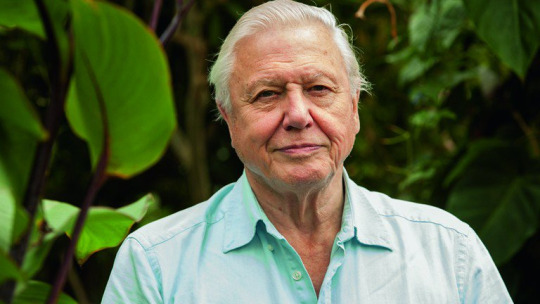
Naturalist, broadcaster, humanist, and national treasure David Attenborough is 95 years old today. Happy Birthday! Thank you for decades of inspirational broadcasting, and all your work to promote the understanding of evolution and the natural world. https://ift.tt/3etHv4D
2K notes
·
View notes
Text
An Interview with Pat O'Brien (Part Two)
Author(s): Scott Douglas Jacobsen
Publication (Outlet/Website): In-Sight: Independent Interview-Based Journal
Publication Date (yyyy/mm/dd): 2016/02/22
Abstract
An interview with Pat O’Brien. He discusses: earned positions on the board of the B.C. Humanist Association, as President of British Columbia Humanist Association, on the board of Humanist Canada, and as President of Humanist Canada;…
View On WordPress
0 notes
Text
Humanist Canada calls for release of Nigerian Humanist President
Humanist Canada calls for release of Nigerian Humanist President
Author(s): Scott Douglas Jacobsen
Publication (Outlet/Website): Medium (Humanist Voices)
Publication Date (yyyy/mm/dd): 2020/05/05
VANCOUVER, British Columbia — May 5, 2020 — PRLog — Canadian Humanists are supporting calls from Humanists International to have Mubarak Bala released from a Nigerian jail. Bala, who is president of the Humanist Association of Nigeria, was arrested by Nigerian…
View On WordPress
0 notes
Text
Ian Bushfield (BCHA) on Humanist Progress, Meetups, Podcasts, Education, and Becoming Involved
Ian Bushfield (BCHA) on Humanist Progress, Meetups, Podcasts, Education, and Becoming Involved
Author(s): Scott Douglas Jacobsen
Publication (Outlet/Website): Medium (Humanist Voices)
Publication Date (yyyy/mm/dd): 2018/12/17
Ian Bushfield, M.Sc., is the Executive Director of the British Columbia Humanist Association (BCHA). The BCHA has been working hard through 2018. Here we talk about some of the updates.
Scott Douglas Jacobsen: The British Columbia Humanist Association has a number…
View On WordPress
0 notes
Text
Conversation with Hanne Stinson — Former CEO, British Humanist Association
Conversation with Hanne Stinson — Former CEO, British Humanist Association
Author(s): Scott Douglas Jacobsen
Publication (Outlet/Website): Medium (Humanist Voices)
Publication Date (yyyy/mm/dd): 2018/01/25
Scott Douglas Jacobsen: How did you first become a humanist? Did this coincide with an atheism?
Hanne Stinson: I was brought up without any religious beliefs, but also encouraged by my parents to respect other people with various religions and to explore different…
View On WordPress
0 notes
Text
British Columbia Humanist Association Working for Marriage Equality for Humanists
British Columbia Humanist Association Working for Marriage Equality for Humanists
Author(s): Scott Douglas Jacobsen
Publication (Outlet/Website): Medium (Humanist Voices)
Publication Date (yyyy/mm/dd): 2017/09/27
The British Columbia Humanist Association (BCHA) created a petition for marriage equality for humanists. It is an ongoing concern for humanists in the province of British Columbia, Canada, in the continual march for equality. The BCHA surpassed their goal of 500…
View On WordPress
0 notes